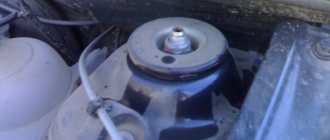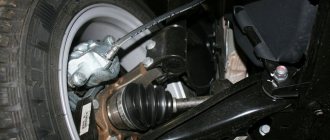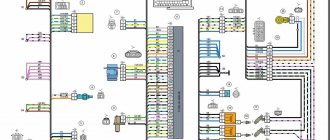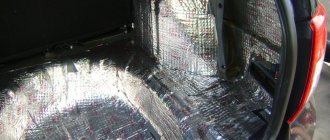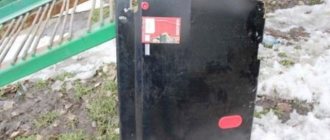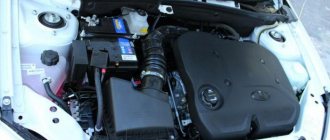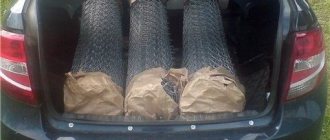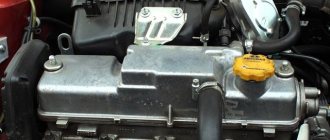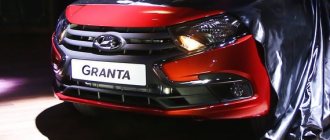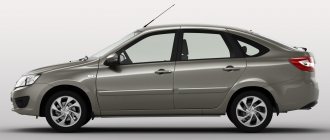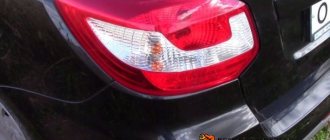In general, I got a knocking sound in the rear of the car - it felt like something was rattling in the trunk... I did this: I wrapped the handbrake cables with electrical tape and hammered them into the mounting eyes with a hammer - it didn’t help. I pulled the cables out of the eyes and just left them hanging like that - it didn’t help. I put everything out of the trunk - it didn’t help. I removed the rods of the trunk opening mechanism and wrapped them with heat shrink and electrical tape - it did not help. I unscrewed the rubber clamps on the trunk to the maximum, but it didn’t help. I wrapped the trunk lock bracket with electrical tape, but it didn’t help. I wrapped the locking brackets on the back of the rear sofa with electrical tape, but it didn’t help. It sounds like aluminum lids hitting each other.
Where to dig next? Share your experience please! .in Lada stores they say - this is Granta's disease - but how to fight - they are silent)))
Ps they seem to say something about the metal boot of the rear pillar - maybe because of it? Because of HBO there are houses in the back - maybe this is the reason for this situation? Knocking like an empty pan)))))
I adjusted the handbrake to 3 clicks. I completely removed the protection above the handbrake adjustment crossbar. I looked at the plug - all the rubber bands were intact - I moved it away from the protection of the gas tank with a plastic tie. I rented houses. I drove from behind - 100% not the rear parcel shelf. Traveled in the trunk.
I don't know where to dig?
A friend is complaining that the partition in the Glushak is broken and it’s supposedly making noise...
After 2 days the pan was found! This is a rod inside the rear beam - it sticks behind the beam and rattles - I cut off a piece of the hose, placed it on ties along almost the entire length of the rod - and silence reigned!
I bought an LG liftback on May 20th, at first everything was ok, but now, or more precisely three days ago, knocking noises appeared in the front right pillar and in the rear on the right side, as mentioned above when driving over bumps, holes, etc. at a low level, I would say “turtle-level” "speed. Rocking the car in the garage also didn’t reveal any knocking noises, quoting one character from Gaidai’s comedy, “It’s a shame, yes.”
right (left, if you sit on the right) and knocking on it at lights out is the result of paying for increased energy intensity. As VAZ specialists said, this knock does not affect anything. This topic has been used since 2011, when the first Grants went out. But regarding the rear, go to the service center under warranty, they will tighten the upper fastening, the knock can also come from the handbrake cable on the body, during a sharp rebound.
I apologize if this has already been discussed, it just hurts my eyes to re-read the entire topic. The point is this: when driving over uneven surfaces, dull knocks were heard from behind. I didn’t attach much importance to this, because... and there was no time, and all this time I drove only on good roads. And then I just decided to check everything specifically, it turned out that the rear pillars were knocking. The question is, did they wear out so quickly or did they forget to put in the necessary cushions at the factory and they hit the metal there, or is this a design feature?
PS I haven’t been able to unscrew it yet, the key is bad, so I’m thinking of buying a normal key and unscrewing it.
I apologize if this has already been discussed, it just hurts my eyes to re-read the entire topic. The point is this: when driving over uneven surfaces, dull knocks were heard from behind. I didn’t attach much importance to this, because... and there was no time, and all this time I drove only on good roads. And then I just decided to check everything specifically, it turned out that the rear pillars were knocking. The question is, did they wear out so quickly or did they forget to put in the necessary cushions at the factory and they hit the metal there, or is this a design feature?
PS I haven’t been able to unscrew it yet, the key is bad, so I’m thinking of buying a normal key and unscrewing it.
the same. there is more on the right, now this sound has appeared on the left as well. There's a seat belt reel mixed in there, exactly on the right. I checked it this way: I tightened the belt - the sound disappeared. Then the truth stopped disappearing, hence the racks. Not critical yet. I went to the diagnostics - they said there was nothing to rattle there..
Recommendations
Comments 10
In my case, the knocking from behind on a rough road was due to a fallen trunk ventilation valve, which was stuck between the bumper and the body.
1) My silencer was knocking in the last suspension rubber band, which was cured by replacement. 2) The knock was due to a weakened clamp for the handbrake cable in the rear beam - it was cured, I bent it and put an elastic band on it. 3) Trunk lock - adjusted, put an elastic band under the loop and unscrewed the rubber bumpers more. 4) there is something else rattling slightly, I think the pads are in the drums. I still don’t know where to dig myself.
For me it turned out that I just tapped the trunk lid lock on the hinge in the closed position, rewound the bracket with electrical tape and unscrewed the stop rubber bands on the lid more.
For me it turned out that I just tapped the trunk lid lock on the hinge in the closed position, rewound the bracket with electrical tape and unscrewed the stop rubber bands on the lid more.
Exactly. Now I was driving, turned onto the gravel road and opened the trunk with the button. The knock is gone. Now I will eliminate it. Thanks to all.
It was the same bullshit. I unscrewed the rubber bands a little, lubricated the lock and that was it.
Maybe the handbrake cable will hold it together. I haven’t tried bending the eyes
I defeated the creaking of the handbrake cable a long time ago. There's just a dull knock. It's as if something in the trunk is moving and knocking. On the previous Mazda it was similar, when the upper mount of the strut became loose. But everything is fine here. I'm starting to complain about the ventilation valve under the bumper. I read that it often flies out and rattles. It's just hard to get to it. Maybe someone else can tell me something. If not, you'll have to remove the bumper...
Try this. On grants on some cars there is a jamb. The rear right fender liner is placed poorly there when the spring is compressed it catches it and pulls it back and releases it, creating the effect of a knock in the car. By cutting the fender liner a little where it touches the spring
There’s also a knocking noise on big bumps, I haven’t looked yet, but I guessed about the fender liner, thanks, I’ll take a look one of these days.
FakeHeader
Comments 10
In my case, the knocking from behind on a rough road was due to a fallen trunk ventilation valve, which was stuck between the bumper and the body.
1) My silencer was knocking in the last suspension rubber band, which was cured by replacement. 2) The knock was due to a weakened clamp for the handbrake cable in the rear beam - it was cured, I bent it and put an elastic band on it. 3) Trunk lock - adjusted, put an elastic band under the loop and unscrewed the rubber bumpers more. 4) there is something else rattling slightly, I think the pads are in the drums. I still don’t know where to dig myself.
For me it turned out that I just tapped the trunk lid lock on the hinge in the closed position, rewound the bracket with electrical tape and unscrewed the stop rubber bands on the lid more.
For me it turned out that I just tapped the trunk lid lock on the hinge in the closed position, rewound the bracket with electrical tape and unscrewed the stop rubber bands on the lid more.
Exactly. Now I was driving, turned onto the gravel road and opened the trunk with the button. The knock is gone. Now I will eliminate it. Thanks to all.
It was the same bullshit. I unscrewed the rubber bands a little, lubricated the lock and that was it.
Maybe the handbrake cable will hold it together. I haven’t tried bending the eyes
I defeated the creaking of the handbrake cable a long time ago. There's just a dull knock. It's as if something in the trunk is moving and knocking. On the previous Mazda it was similar, when the upper mount of the strut became loose. But everything is fine here. I'm starting to complain about the ventilation valve under the bumper. I read that it often flies out and rattles. It's just hard to get to it. Maybe someone else can tell me something. If not, you'll have to remove the bumper...
Creaks and knocks in the front suspension of the Lada Granta: causes and diagnostics
Comfort when driving a Lada Granta car consists of many factors, one of which is the operation of the front suspension. Knocking, noise, and “breakdowns” of the suspension also affect traffic safety, so timely diagnosis of breakdowns of this unit is simply necessary. It is better to carry it out at a service center, but some faults can be identified yourself.
Probable causes of suspension malfunction
View of the front suspension “from under the wheel”
The unpleasant creaking of the front suspension of the Lada Grant, “breakdowns” in its operation lie in the malfunction of the elements of this component of the car. Conventionally, they can be divided into two groups: the shock absorber strut with its contents and all the rest. The reason for separating the strut into a separate category is due to the increased load on it: it simultaneously performs the function of an upper arm and dampens vertical vibrations of the wheel.
The main causes of malfunctions of the telescopic stand include the following:
- Loosening of the attachment of its upper support to the supporting body.
- Destruction of the rubber buffer.
- Liquid leakage from the shock absorber, scuffing on its rod, damage to the chrome coating of the rod.
The shock absorber is leaking (needs replacement)
In the photo: lower lever assembly with ball
Damage to the ball joint is also possible, usually caused by an overestimated service life or the installation of a substandard part. Worn rubber bushings in the stabilizer and braces will also affect the smoothness of the suspension. Breakage of the main spring is unlikely, but natural wear or installation of a non-standard model can cause a loss of elasticity of the suspension as a whole.
Self-diagnosis of faults in the front suspension
There are several explanations for even one symptom of a breakdown, so it is better to identify the true cause of the malfunction at a bus station.
The following groups of signs of deviations in the operation of the front suspension can be distinguished:
- Spontaneous deviation from straight-line movement, “yaw” of the machine.
- Noises, knocks, “breakdowns” when driving on uneven roads.
- Reduced service life of suspension elements, their rapid failure.
The paint on the stand has come off and the stand has begun to rust.
The first group usually includes malfunctions of the stabilizer. You can visually inspect the entire suspension and, if there are no signs of dents or deformations, then it is worth checking the setting of the toe-in/camber angles of the front wheels. Externally, their deviation is observed in the uneven wear of the tread of the front wheels, but it will take some time for the tires to wear out.
There is a chance to detect this failure by ear: when entering a turn, you will hear the creaking of rubber, and the steering wheel usually does not return to its original position on its own.
A creaking sound in the front suspension is one of the temporary malfunctions of a Lada Granta car if it is caused by operating the car on a polluted or sandy road. In this case, sand particles may get into the rubber seals (silent blocks) of the stabilizer or braces. After washing the noise disappears.
The “couldn’t be simpler” suspension is just a plus.
The suspension is “simple to the point of disgrace”, a crab, a strut, a lower ball, two silent blocks - and that’s it, that’s all its capital.
After any work that involves disconnecting the hub from the strut, it is necessary to do a wheel alignment. As a last resort, you can try using a chisel to make marks on the strut and on the camber bolt (it's on top).
Knocking noise when driving over uneven surfaces
Knocking in the suspension when driving over uneven surfaces is also uncharacteristic: the Lada Granta, although not an off-road vehicle, is quite capable of overcoming small bumps. Typically, knocking noises occur when fasteners are loosened, nuts are tightened, or the ball joint or shock absorber strut is worn out.
If the service life of the suspension elements is too short, there are usually two reasons: poor quality of the parts used or an overly dynamic, aggressive driving style.
It is also worth paying attention to the compliance of the front wheel rims and tires themselves with those recommended by the manufacturer.
Shock absorber malfunctions
The shock absorber may knock at the top or bottom mounting point.
The reason for this may be the loosening of the fastening bolts or an increase in play in the mounting holes. Visually, wear or breakage of the springs can be determined by the vehicle's seat level. If the spring has sagged too much or is broken, this will be visible from the fit of the body. When driving, a broken spring will make a characteristic sound. To preserve shock absorbers, it is recommended to fill them with oil of the viscosity specified by the manufacturer (provided that the shock absorbers are dismountable). In winter, never make a sudden start in a cold car. You can damage not only the engine, but also the shock absorbers, since the oil in them is also not warmed up. This will take care of the shock absorber struts and increase their service life.
Often the stand can be the cause of a knock. Especially when driving on uneven roads (knocking on bumps, uneven surfaces) or when a wheel falls into a hole. To check the strut, you need to push vertically on the fender or hood. With a proper stance, the car smoothly returns to its original position. Otherwise, you will hear creaking and sudden movement.
A possible cause of a knocking noise in the strut could be a loose lock nut. This malfunction can be identified by the car swaying while driving and decreased controllability. In this case, noise occurs randomly. The nut must be tightened, otherwise you risk losing control of the car on the road.
Lada Granta suspension device
Front suspension device (diagram)
This car uses an independent suspension with one lever, to which the lower part of the steering knuckle is screwed. Its top is mounted to the shock absorber strut, the operation of which differs from many similar units on domestic cars. When you turn the steering wheel, the fist with the shock absorber strut and the spring placed on it rotates. The shock absorber auger, screwed through a bearing to the upper strut support, remains stationary.
The ball joint provides flexible articulation between the steering knuckle and the suspension arm. The camber angle is adjusted traditionally for front-wheel drive versions of VAZ cars - with a nut with an eccentric on the main shock absorber strut, at the point where it connects with the steering knuckle. The suspension is kept from directional fluctuations by a common anti-roll bar and braces on both sides of the suspension.
Details in the photo
All suspension elements are in the photo below
Weak points of the suspension
In wet weather it is not always possible to see a defect in the shock absorber strut
If you carry out independent repairs, for example, replacing a ball joint, then you must carefully tighten the fastening bolts. There are no through holes in the steering knuckle to which the support is attached: the bolt is screwed into the knuckle itself. Excessive tightening force may cause the bolt to break. A knock in the front suspension may also occur for this reason.
For reliable and long-term operation of the suspension, it is necessary to comply with the speed limit of the machine stated in its technical passport. Also, regular maintenance will help eliminate the appearance of noise, knocking and deviation from straight-line movement.
Knocks in the suspension and transmission on a Lada Granta VAZ 2190
| 1 — cover; 2 — ball joint; 3 - retaining ring; 4 — hub bearing nut; 5 — protective cap; 6 — hub; 7 — hub bearing; 8 — steering knuckle; 9 — front wheel brake disc; 10 — brake mechanism shield; 11 - nut; 12 — eccentric (adjusting) bolt; 13 — rotary lever; 14 — front suspension spring; 15 — shock absorber rod; 16 — upper spring cup; 17 — upper support of the shock absorber strut; 18 — shock absorber rod nut; 19 — bearing of the upper support of the shock absorber strut; 20 — spring gasket; 21 — front suspension compression buffer; 22 — protective casing; 23 — telescopic stand; 24 — front wheel drive shaft; 25 — bracket for mounting the anti-roll bar cushion; 26 — front suspension stretch; 27 — anti-roll bar; 28 — stabilizer bar; 29 — front suspension arm |
| |
| If extraneous knocking noises appear in the suspension of a moving Lada Granta, you must immediately determine their source, regardless of whether the knocking is constant or appears only when driving over uneven surfaces. WARNING Malfunctions in the suspension of the Lada Granta VAZ 2190 car can lead to a serious accident! | Check the suspension according to the method outlined in the subsections “Checking the technical condition of front suspension parts on a car”; “Checking the technical condition of rear suspension parts on a car.” USEFUL ADVICE It is better to check the condition of the suspension on a Lada Granta VAZ 2190 car installed on an overpass, inspection hole or lift, and if this is not possible, you can check the condition of the suspension on a free flat area, although with less convenience. In any case, you will need an assistant. | It is quite difficult to diagnose the serviceability of transmission components by the noise they emit. If you are unable to pinpoint the source of noise (knocking) in your suspension or transmission, contact a qualified technician. Repair or replace failed transmission components (see Section 6 “Transmission”). |
Possible causes of knocking in the suspension on a Lada Granta VAZ 2190 car and ways to eliminate them
| Cause of malfunction | Remedy |
| Shock absorber struts are faulty The nuts securing the vehicle's stabilizer bar are loose; worn out cushions and rubber-metal hinges (silent blocks) Damage, deformation of rubber-metal hinges (silent blocks) of levers, upper supports of shock absorber struts Wear of ball joints of front suspension arms Increased clearance in front wheel hub bearings Large wheel imbalance Wheel rim deformation Settlement or breakage of the suspension spring Wear of rubber-metal hinges (silent blocks) of rear suspension arms Knock from suspension breakdown due to destruction of compression buffers Frequent “breakdowns” of the rear suspension due to overload of the rear axle | Replace or repair shock absorber struts Tighten the rod fastening nuts; if the rubber cushions are worn out, replace them, replace the damaged parts of the car's anti-roll bar Replace the arms, upper strut mounts Replace ball joints Balance the wheel Replace rubber-metal hinges (silent blocks) |
Consequences of ignoring a knock
Any extraneous sounds that appear while driving must be identified without delay, as their presence may indicate a serious malfunction. In this case, let’s look at the consequences of knocking in the rear suspension:
- If problems arise in the guides and are not resolved in a timely manner, in addition to material costs, controllability may deteriorate; in some cases, this malfunction leads to a situation where the suspension is secured only by a spring and a shock absorber. The result is wear and tear of all elements, creating an emergency situation.
- If the spring is damaged, the car sways on uneven roads. In addition, the spring does not limit the movement of the shock absorber. The result of spring wear is terrible stability of the car on the road and damage to other suspension elements.
- Failure of shock absorbers is accompanied by a constant knocking sound. As a result, severe wear occurs on the fastening elements, as well as the shock absorbers themselves. In this case, controllability deteriorates significantly, and strong roll is possible when turning at high speed.
In most cases, a knock in the rear suspension is detected almost immediately, as it occurs while overcoming a bump or pothole on the road. As a rule, suspension elements fail after their service life has expired. If you replace parts in a timely manner, you can avoid road accidents and serious material costs.
A trip to the dealer
The struts weren't leaking yet, but I was getting pretty tired of the knocking noise, so I decided to go to a car dealership. I made an appointment for repairs a week in advance; I live in another city 300 km from the salon. At the same time, I decided to diagnose the entire suspension and replace what was needed.
I arrived a little earlier than expected and approached the repairman. I thought they would accept the car earlier, but there was no free space, so I had to wait.
I've had repairs done at a dealer before and I liked the attitude. Polite service, conscientious craftsmen. Worn parts are returned. During renovations, you can come in and see how the work is progressing.
Diagnostics
The Lada Granta was driven into the repair bay and raised on a lift. I explained the problems and said that something was knocking in front.
I forgot to say that before the lift the car was checked at a stand. The front end was subjected to vibration and the operation of the struts was checked. It turned out that they were normal.
The mechanic advised not to change the racks, since by all indications they were in good working order. I checked the chassis and suspension, tapped the front brake calipers - they made a metallic ringing sound. I said the knocking noise when driving was similar.
What did you decide to repair?
Together with a mechanic and a repairman, we decided that the following needed to be changed and repaired:
- Replace the rubber bands of the levers (daisies).
- Replace the stabilizer struts (in common parlance, eggs).
- Lubricate the brake caliper guides.
- Replace brake linings and pads on all 4 wheels. Although the rear ones were not too worn, I decided to change them.
- The handbrake cables were rotted at the bends near the rear wheels. The braid broke, water got in, and everything rusted. As a result, the right rear wheel was not stopped by the handbrake. Therefore, it was decided to change both cables.
- We also decided to replace the two outer CV joints. I knew this even at home, since a characteristic crunch was heard when turning.
The master calculated the cost of spare parts and labor. It turned out that for cars older than 6 years there is a 20% discount on spare parts. Therefore, we calculated 12,566 rubles for everything.
I left the car at the dealership and drove into town. They said it would take about 4 hours to get it repaired by the dealer. Later they called me and said that the rear brake drums were very scuffed. They asked whether we would change it or not, to which I agreed to replace it.
Troubleshooting in the rack
Basically, the strut can make a knock and transmit impacts from uneven roads only when the entire structure is severely worn. Moreover, this element of the car suffers the most when the front pair of wheels falls into a deep hole - the rebound strut does not work, but the spring undergoes a sharp straightening.
New Lada: How to check whether the mileage is twisted or not on a VAZ
Checking the functionality of the support pillar is carried out in a standard way - the vehicle is swung vertically or a partner presses forcefully on the central part of the hood. If the rack is in good condition, the body of the machine should return to its original state once without sharp straightening.
If the case falls sharply, you will hear a dull thud. This indicates a malfunction of the element due to a loose lock nut, which makes noise inside the support post itself. Repair of the rack should only be carried out at a car service center, since special equipment will be used to secure all elements in a high-quality manner.
If a knock occurs on small bumps due to the strut, the car sways strongly when moving and loses control. This may result in an accident on uneven roads.
Also, problems may lie not in the strut itself, but in the shock absorbers. A malfunction of the shock absorber system is primarily due to improper treatment with oil. Drivers often pour an oil solution with incorrect viscosity characteristics inside. This value is affected not only by the purchased oil, but also by the ambient temperature at which the solution is poured. Too low a temperature does not allow the oil fluidity to increase to the required value.
The car is ready
About 4 hours later they called me and informed me that the car was ready and I could pick it up. I arrived, paid for the repair using my card, picked up the car and drove home. I tried to drive over bumps and uneven surfaces - surprisingly, there was no more knocking in the suspension!
It’s good that I didn’t change the racks, otherwise I would have had to fork out a considerable amount!
If you have had similar cases, share in the comments. Subscribe to the channel so as not to miss interesting posts about the Lada Grant.
Let's sum it up
There are many interesting options for car repair. Among them there is also self-diagnosis. This is a great advantage for every owner that you can do your own research on the car, detect problems, and go to the service already prepared for all the nuances. Our modern service stations do not always tell the truth about problems, make incorrect diagnoses and make money out of the blue. This is why there is an outflow of customers to garage foremen. Sometimes the latter offer much better quality of services.
There are indeed many complex elements in the rear suspension, and sometimes it is very difficult to diagnose. But in fact, you just need to gain a little experience in order to more or less understand the details of the chassis. This will help you simply carry out the necessary actions and get a more or less good inspection of the car yourself. If you have a master whom you completely trust, it is better to contact such a specialist. This will help you find the cause much faster and perform high-quality repairs in a matter of hours. How do you prefer to detect the causes of knocking noises in your car's suspension?
